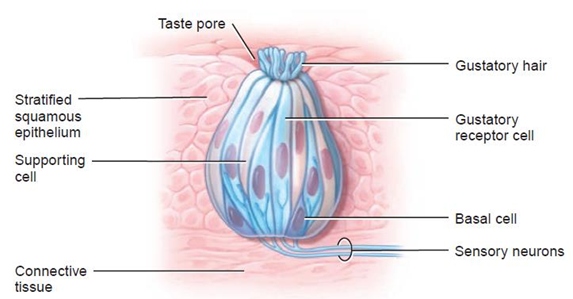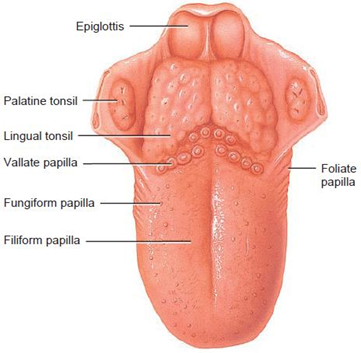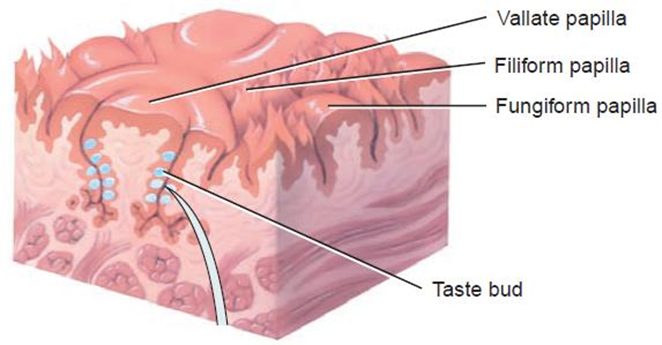GUSTATION: SENSE OF TASTE
Objectives
At the end of this lecture, student will be able to
• Describe the anatomy of taste bud and papillae
• Explain the physiology of gustation and gustatory pathway
GUSTATION: SENSE OF TASTE
• Taste or gustation like olfaction, is a chemical sense
Five primary tastes can be distinguished:
• Sour, sweet, bitter, salty, and umami
• Umami taste, recently reported by japanese scientists, is described as “meaty” or “savory”
Anatomy of Taste Buds and Papillae
• Receptors for sensations of taste, located in the taste buds
• Taste bud – an oval body consisting of three kinds of epithelial cells
a) Supporting cells
b) Gustatory receptor cells
c) Basal cells
• Supporting cells surround about 50 gustatory receptor cells
• A single, long microvillus, called a gustatory hair
Projects from each gustatory receptor cell to the external surface
• Through the taste pore (opening in the taste bud)
• Basal cells, stem cells found at the periphery of the taste bud
• Produce supporting cells, develop into gustatory receptor cells
• Gustatory receptor cells synapse with dendrites of the first-order neurons
• Form the first part of the gustatory pathway
Papillae
• Taste buds are found in elevation on the tongue, Papillae
• Provide a rough texture to the upper surface of the tongue
• Three types of papillae contain taste buds
a) Vallate (circumvallate) papillae
b) Fungiform papillae
c) Foliate papillae
Circular vallate (circumvallate) papillae
• About 10-12, form an inverted V-shaped row at the back of the tongue
• Each of these papillae houses 100–300 taste buds
Fungiform papillae
• Mushroom-shaped elevations scattered over the entire surface of the tongue
• Contain about five taste buds each
Foliate papillae
• Located in small trenches on the lateral margins of the tongue
• Most of their taste buds degenerate in early childhood
Physiology of Gustation
Chemicals that stimulate gustatory receptor cells are known as tastants, Tastant is dissolved in saliva
â
Contact with the plasma membrane of the gustatory hairs (sites of taste transduction)
â Receptor potential
Exocytosis of synaptic vesicles from the gustatory receptor cell
â
Neurotransmitter release
â
Nerve impulses in the first-order sensory neurons
The receptor potential arises differently for different tastants
• Sodium ions (Na+) in a salty food enter gustatory receptor cells
• Via Na+ channels in the plasma membrane
• Accumulation of Na+ inside cause depolarization
• Leads to release of Neurotransmitter
Tastants, responsible for stimulating sweet, bitter, and umami tastes
• Bind to receptors on the plasma membrane that are linked to G proteins
• Activate second messengers
• Depolarization; release of neurotransmitter
The Gustatory Pathway
• Gustatory receptor cells trigger nerve impulses in cranial nerves VII (facial), IX (glossopharyngeal) and X (Vagus)
• Taste signals then pass to the medulla oblongata, thalamus, and cerebral cortex (parietal lobe)
Summary
• Gustation is a chemical sense
• Five primary tastes – Sour, sweet, bitter, salty, and
umami
• Receptors for sensations of taste are located in the taste
buds
• Tastants binds to receptors; generates potential; release
of neurotransmitter; initiates nerve impulse
• Taste signals pass to the medulla oblongata, thalamus, and
cerebral cortex (parietal lobe)
Also, Visit:
B. Pharma Notes | B. Pharma Notes | Study material Bachelor of Pharmacy pdf



